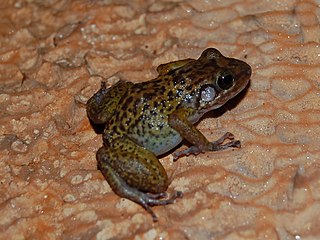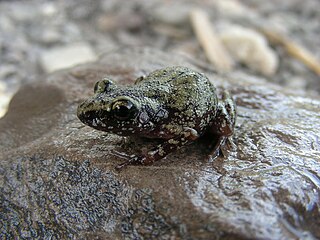The spine-fingered tree frog is a species of frog in the family Hylidae endemic to Mexico. Its natural habitat is subtropical or tropical moist montane forests and rivers. It is found in the Sierra Madre del Sur of Guerrero state, on Cerro Teotepec between 1,450 and 2,415 meters elevation, and northwest of Asoleadero. Its extent of occurrence (EOO) is 478 km2.
Schultze's stream frog is a species of frog in the family Hylidae endemic to Mexico. It is only known from the Pacific slopes of the Sierra Madre del Sur in Oaxaca and Guerrero states. Its natural habitats are pine-oak and cloud forests. It occurs in or on low vegetation along mountain streams. It is anuncommon species threatened by habitat loss from deforestation and the planting of coffee and other non-timber plantations. Also chytridiomycosis is suspected.
Craugastor aphanus is a species of frog in the family Craugastoridae. It is endemic to the Sierra del Mico and Sierra de las Minas ranges in the Izabal Department of eastern Guatemala.
Craugastor guerreroensis, also known as the Guerreran robber frog, is a species of frog in the family Craugastoridae. It is endemic to Mexico and only known from its type locality near Agua del Obispo, in the municipality of Chilpancingo de los Bravo, Guerrero.
Gunther's robber frog, Günther's robber frog, or Guerreran robber frog is a species of frog in the family Craugastoridae. It is endemic to the Sierra Madre del Sur in the Guerrero state, Mexico. Its natural habitats are pine, oak, and pine-oak forests with plenty of leaf-litter on the ground. It is a relatively common species but declining and threatened by habitat loss and disturbance.
Craugastor uno is a species of frog in the family Craugastoridae. It is endemic to Mexico and known from the Sierra Madre del Sur in Guerrero and southern Oaxaca. Common names Savage's robber frog and strange robber frog have been coined for it. The specific name uno refers to uniqueness of this species among its relatives.

The Barahona rock frog, or Hispaniola dwarf robber frog, is a species of frogs in the family Eleutherodactylidae that is endemic to southern Hispaniola.
South Island telegraph frog is a species of frog in the family Eleutherodactylidae endemic to Hispaniola. It occurs in the Massif de la Hotte and Massif de la Selle, Haiti, and in the Sierra de Baoruco, the Dominican Republic.
Eleutherodactylus casparii is a species of frog in the family Eleutherodactylidae endemic to Sierra de Trinidad, Cienfuegos Province, Cuba. Its natural habitat is mesic forest, but it also occurs in anthropogenic habitats such as plantations and in introduced vegetation. It is threatened by habitat loss.

Eleutherodactylus dilatus is a species of frog in the family Eleutherodactylidae. It is endemic to Mexico and restricted to the Chilpancingo region of the Sierra Madre del Sur in central Guerrero. Its common name is Guerreran peeping frog.

Eleutherodactylus intermedius is a species of frog in the family Eleutherodactylidae endemic to eastern Cuba where it is known from the Sierra Maestra and Sierra del Cobre. Its common name is Pico Turquino robber frog, in reference to its type locality.
The La Selle dusky frog or Mable's robber frog, Eleutherodactylus jugans, is a species of frog in the family Eleutherodactylidae. It is endemic to Hispaniola and known from the Massif de la Selle, both in the Dominican Republic and in Haiti. Its natural habitats are mesic pine and broadleaf forests. It is threatened by habitat loss. It is moderately common in suitable habitat, but threatened by habitat loss caused by logging and agriculture. It is known from both La Visite National Park (Haiti) and Sierra de Bahoruco National Park, but habitat degradation is occurring in these areas too.

The southern pastel frog or Hispaniola robber frog, Eleutherodactylus leoncei, is a species of frog in the family Eleutherodactylidae. It is endemic to Hispaniola and known from the Massif de la Selle, both in the Dominican Republic and in Haiti. Its natural habitats are upland pine forests. Males call from the ground. It is threatened by habitat loss caused by logging and agriculture. It is known from the Sierra de Bahoruco National Park, but habitat degradation is occurring in this area too.

Eleutherodactylus longipes is a species of frog in the family Eleutherodactylidae. It is endemic to Mexico and occurs on the Sierra Madre Oriental between central Nuevo León and adjacent Coahuila in the north and northern Hidalgo in the south. It is also known as the long-footed chirping frog and longfoot robber frog, among other names.

Eleutherodactylus pipilans is a species of frog in the family Eleutherodactylidae. It is found in southern and southeastern Mexico and southwestern Guatemala.
Eleutherodactylus zeus is a species of frog in the family Eleutherodactylidae. It is endemic to western Cuba and known from the Sierra de los Órganos and the Sierra del Rosario, in the Pinar del Río and Artemisa provinces. Its natural habitats are rock crevices and caves in mesic broadleaf forest in limestone areas. It is threatened by habitat loss and disturbance associated with tourism.
Pseudoeurycea amuzga, which has been given the common name of Sierra de Malinaltepec salamander, is a species of salamander in the family Plethodontidae. It is endemic to Mexico and known only from Sierra de Malinaltepec, a part of Sierra Madre del Sur in the Guerrero state.
Thorius grandis, commonly known as the grand minute salamander, is a species of salamander in the family Plethodontidae. It is endemic to Mexico where it is found in west-central Sierra Madre del Sur in Guerrero. Its natural habitats are pine-fir and pine-oak-fir forests; it tolerates some habitat modification. It usually occurs under logs or the bark of fallen rotting logs. It is threatened by habitat loss caused by logging and expanding agriculture.
Thorius infernalis, commonly known as the Atoyac minute salamander, is a species of salamander in the family Plethodontidae. It is endemic to Mexico where it is only known from its type locality in the Sierra Madre del Sur mountains in central Guerrero. Its natural habitat is riparian vegetation along hillsides, presumably in forest. Much of the potential habitat is already converted into coffee plantations. It is threatened by habitat loss caused by expanding agriculture and human settlements.
The Sierra Madre frog, Lithobates sierramadrensis, is a species of frog in the family Ranidae endemic to the Sierra Madre del Sur in Guerrero and Oaxaca states, Mexico. Its local name is rana de Sierra Madre Occidental. Its natural habitats are conifer forests at intermediate elevations. Breeding takes place in streams. It is threatened by habitat loss (logging) and possibly chytridiomycosis.






